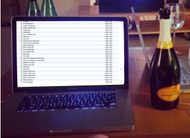Fashioning Change
A social entrepreneur tries to change the way people shop.

When I first entered the start-up world, I found the landscape tricky to navigate — especially as a nontechnical founder of a technology company. How could the founder of a tech start-up not know anything more than HTML? How was I going to hire the right people with the right skills to build the lines of code I needed if I didn’t understand what I was looking for?
Hoping to gain a better understanding, I took a trip to Santa Monica and participated in a Startup Weekend. Over the course of the weekend, I spoke with more than 50 engineers, and I asked every one the same question: “If you were going to build Fashioning Change, how would you do it?” After the weekend was over, I analyzed the notes and compiled the similarities. With that, I was able to build an engineering job description and begin the search for a qualified person to join me in creating the Fashioning Change shopping platform (which I explained in a previous post).
But that still wasn’t enough — I can be a bit of a skeptic. When I am unsure of something, it’s not enough for me to take someone’s word. So while all of my friends were going out on Friday and Saturday nights, I began a new routine. Week after week, I would open a bottle of wine, buy WordPress templates, break them, and then put them back together (this was before Code Academy existed). I learned enough to build a browser add-on using a third-party API and an e-commerce site that aggregated popular green products. The site was “janky” and the browser add-on would flash green-living information at the wrong times, but I gained an understanding of the job description I had put together and built an early proof of concept for my start-up. Most important, learning to code made it easier for me to understand what I was looking for and to weed out résumés that were irrelevant.
It was while I was learning to hammer out a line of code that I met Kevin Ball, who had just moved to San Diego with his wife and had worked previously at Causes. We met in a co-working space when he noticed that I was stuck on a line of code and offered to help. He fixed instantly something I had been struggling with for hours. He had a great background that fit the description of what I was looking for, and he happened to be looking for his next thing. So together, we did a four-month trial project and built a green-living tip app. The project went well, and we decided to proceed with Fashioning Change.
These days, I frequently get asked how I recruited Kevin, who is known for being worth five or six normal engineers. I think Kevin saw that rather than sitting around and waiting for an engineer to join me, I took initiative to get started. But when I tell people how I gave up my Friday and Saturday nights to learn to code, the response I often get is, “That’s too hard.” I tell people that if they think that learning to code is too hard, then they are never going to make it as an entrepreneur.
They usually don’t like my response, but I think it’s true. There is always going to be some hurdle that your start-up needs to get over and that you have never previously encountered. If you can’t get your hands dirty to figure out a solution, it’s not worth diving into the start-up world.
What do you think?
Adriana Herrera is chief executive of Fashioning Change. You can e-mail her at adrianah@fashioningchange.com, and you can follow her on Twitter at @Adriana_Herrera.
Article source: http://boss.blogs.nytimes.com/2013/04/02/finding-a-coder-when-you-dont-know-how-to-code/?partner=rss&emc=rss